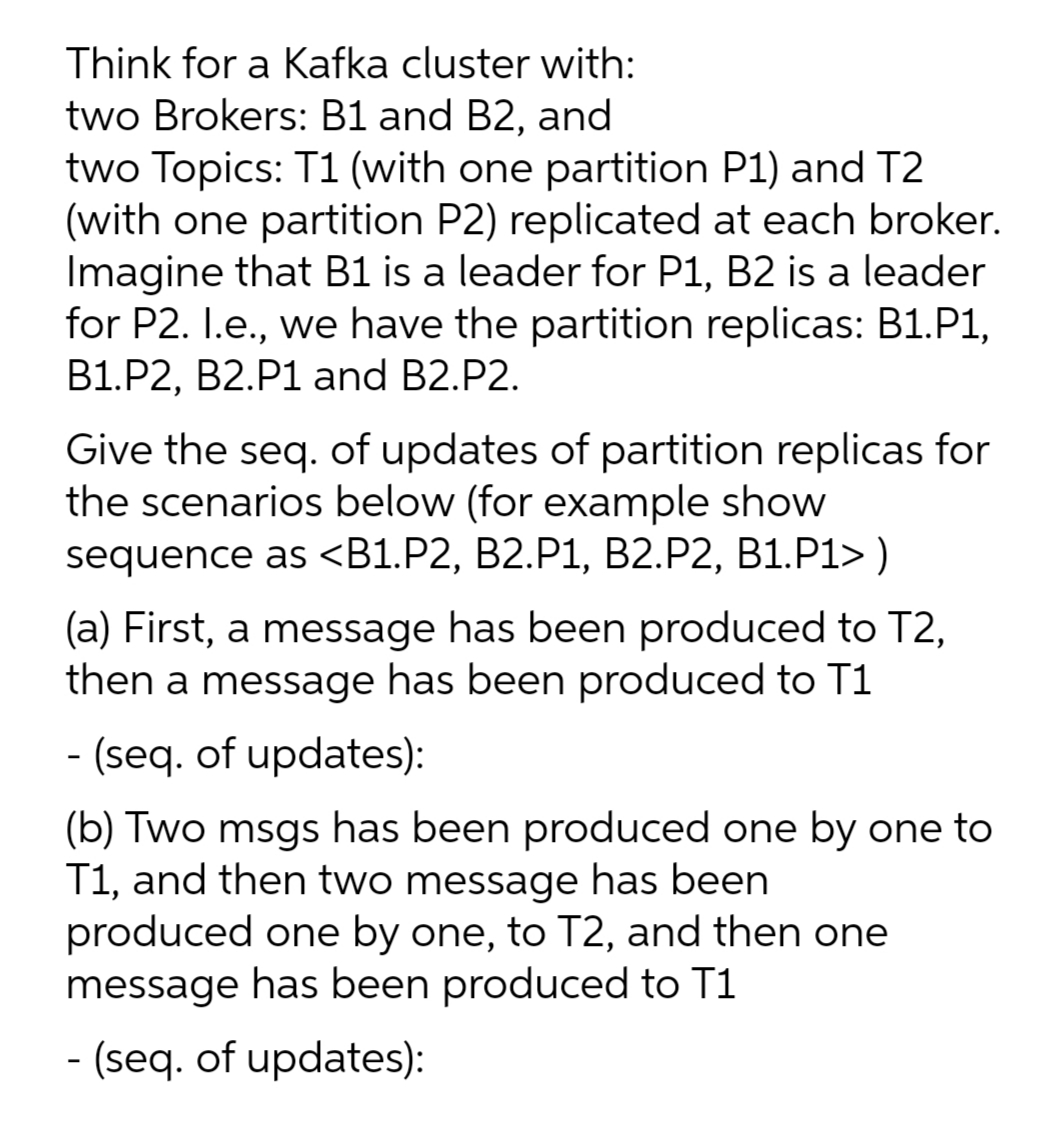Think for a Kafka cluster with: two Brokers: B1 and B2, and two Topics: T1 (with one partition P1) and T2 (with one partition P2) replicated at each broker. Imagine that B1 is a leader for P1, B2 is a leader for P2. I.e., we have the partition replicas: B1.P1, B1.P2, B2.P1 and B2.P2. Give the seq. of updates of partition replicas for the scenarios below (for example show sequence as ) (a) First, a message has been produced to T2,
Think for a Kafka cluster with: two Brokers: B1 and B2, and two Topics: T1 (with one partition P1) and T2 (with one partition P2) replicated at each broker. Imagine that B1 is a leader for P1, B2 is a leader for P2. I.e., we have the partition replicas: B1.P1, B1.P2, B2.P1 and B2.P2. Give the seq. of updates of partition replicas for the scenarios below (for example show sequence as ) (a) First, a message has been produced to T2,
Computer Networking: A Top-Down Approach (7th Edition)
7th Edition
ISBN:9780133594140
Author:James Kurose, Keith Ross
Publisher:James Kurose, Keith Ross
Chapter1: Computer Networks And The Internet
Section: Chapter Questions
Problem R1RQ: What is the difference between a host and an end system? List several different types of end...
Related questions
Question
7

Transcribed Image Text:Think for a Kafka cluster with:
two Brokers: B1 and B2, and
two Topics: T1 (with one partition P1) and T2
(with one partition P2) replicated at each broker.
Imagine that B1 is a leader for P1, B2 is a leader
for P2. I.e., we have the partition replicas: B1.P1,
B1.P2, B2.P1 and B2.P2.
Give the seq. of updates of partition replicas for
the scenarios below (for example show
sequence as <B1.P2, B2.P1, B2.P2, B1.P1> )
(a) First, a message has been produced to T2,
then a message has been produced to T1
- (seq. of updates):
(b) Two msgs has been produced one by one to
T1, and then two message has been
produced one by one, to T2, and then one
message has been produced to T1
6.
- (seq. of updates):
Expert Solution
This question has been solved!
Explore an expertly crafted, step-by-step solution for a thorough understanding of key concepts.
This is a popular solution!
Trending now
This is a popular solution!
Step by step
Solved in 2 steps with 2 images

Recommended textbooks for you

Computer Networking: A Top-Down Approach (7th Edi…
Computer Engineering
ISBN:
9780133594140
Author:
James Kurose, Keith Ross
Publisher:
PEARSON

Computer Organization and Design MIPS Edition, Fi…
Computer Engineering
ISBN:
9780124077263
Author:
David A. Patterson, John L. Hennessy
Publisher:
Elsevier Science

Network+ Guide to Networks (MindTap Course List)
Computer Engineering
ISBN:
9781337569330
Author:
Jill West, Tamara Dean, Jean Andrews
Publisher:
Cengage Learning

Computer Networking: A Top-Down Approach (7th Edi…
Computer Engineering
ISBN:
9780133594140
Author:
James Kurose, Keith Ross
Publisher:
PEARSON

Computer Organization and Design MIPS Edition, Fi…
Computer Engineering
ISBN:
9780124077263
Author:
David A. Patterson, John L. Hennessy
Publisher:
Elsevier Science

Network+ Guide to Networks (MindTap Course List)
Computer Engineering
ISBN:
9781337569330
Author:
Jill West, Tamara Dean, Jean Andrews
Publisher:
Cengage Learning

Concepts of Database Management
Computer Engineering
ISBN:
9781337093422
Author:
Joy L. Starks, Philip J. Pratt, Mary Z. Last
Publisher:
Cengage Learning

Prelude to Programming
Computer Engineering
ISBN:
9780133750423
Author:
VENIT, Stewart
Publisher:
Pearson Education

Sc Business Data Communications and Networking, T…
Computer Engineering
ISBN:
9781119368830
Author:
FITZGERALD
Publisher:
WILEY